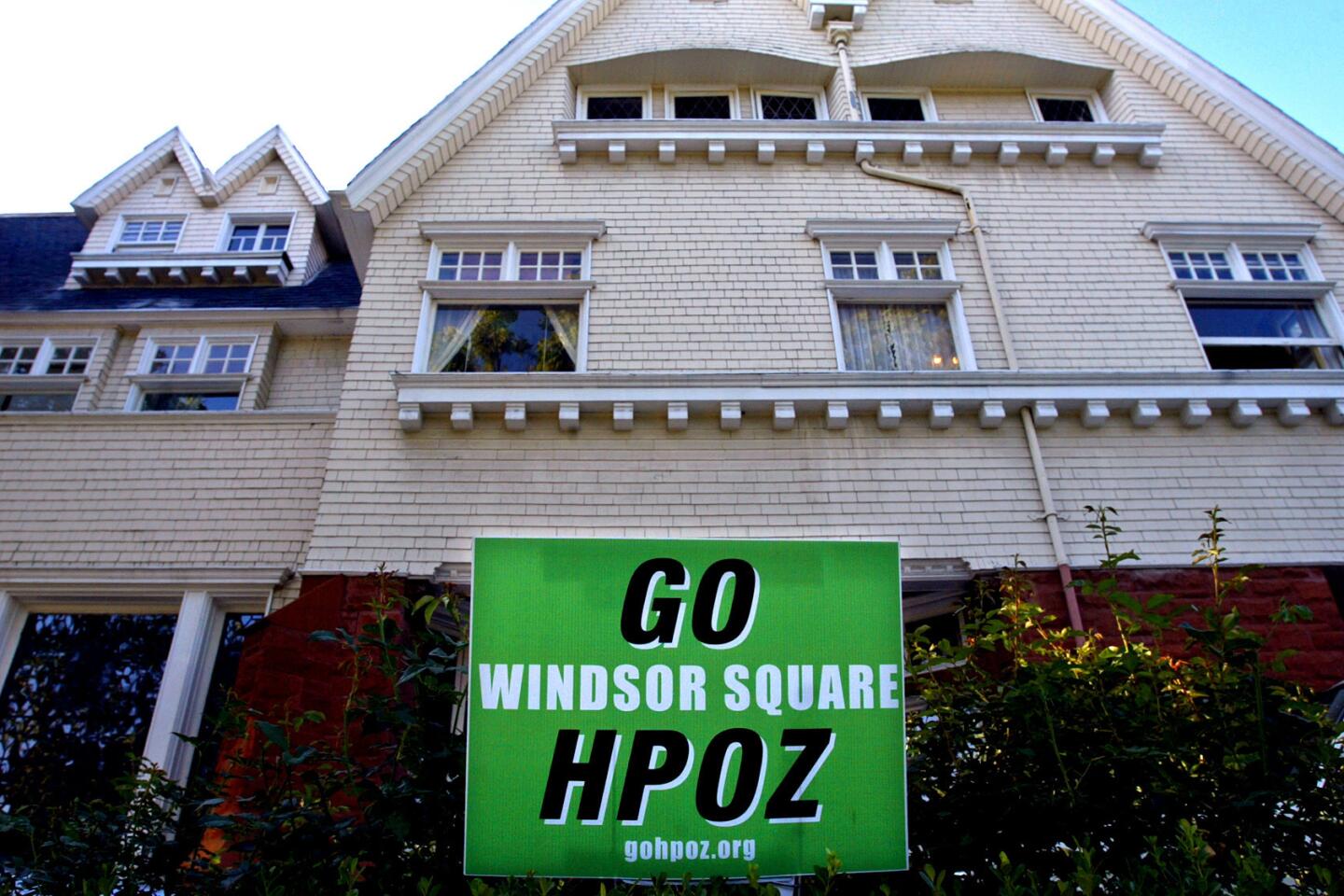When neighbors can’t agree on historic designation
A person’s home is an inherently emotional asset, so the process of creating a historic district — which can protect distinctive architecture, or handcuff a homeowner’s desires, depending on your viewpoint — can be a fear-driven process, rife with accusations and entrenched positions.
“Neighbors were basically sitting in a room screaming at each other — it was very contentious,” said Bettina O’Mara, who, with other neighbors, battled a proposed Holmby-Westwood Historic Preservation Overlay Zone, defeated in 2016.
Protecting a neighborhood’s historic details has a principled and even honorable ring to it. But participants say arriving at consensus over a proposed HPOZ — L.A.’s designation for its historic districts — can be like a battle between today’s polarized political camps. And similar to crafting legislation, the creation process can be likened to sausage-making –– perhaps it’s better that you just don’t know.
Los Angeles adopted its HPOZ ordinance in 1979; the historic districts now number 35, harboring 21,000 properties. Generally, groups of homes within a neighborhood need to be built during a “period of significance,” such as from 1905-1941, to become HPOZ-worthy. Residents in neighborhoods kick-start the process by rallying neighbors in support of the districts. Once one is approved, the city’s Planning Department and HPOZ boards review proposed alterations to exteriors of homes within their zones.
“What freaked out the Westwood folks is that they were going to have other neighbors tell them what they can or can’t do to their homes,” said Ben Reznik, a Century City-based land-use attorney. Reznik was among attorneys and a lobbying company that neighbors brought in to advance the opposition.
Under contention in the neighborhood: 1,044 properties, 62% of which were deemed Period Revival architecture built from 1925 to 1959.
In July 2016, neighbors sent a petition with more than 500 signatures to Councilman Paul Koretz. Those dissidents contended a historic zone would “severely suppress property values” and cited “very stringent” approval standards and a lengthy process for proposed home changes, among other points.
“There was some inaccurate information spread,” Principal City Planner Ken Bernstein said.
“About 90% of what our HPOZ team reviews falls under conforming work,” Bernstein said — benign changes including roof repair, exterior paint color swaps and small rear additions, which can be approved in three to 21 days.
“The fears about HPOZs are way out of proportion to the reality,” said Adrian Scott Fine, director of advocacy at the L.A. Conservancy. He called the HPOZ boards “judicious,” with proposed home changes approved in the high 90% range.
Falsehoods were rebutted in a mailer sent by HPOZ supporters. The corrections: Modern-style homes can be built, homes on corner lots can be expanded and second-story additions are allowed.
In fact, significant additions are common within historic zones, although they require a higher-level review of up to 75 days, and a fee that tops out at $2,600. If denied, an application can be appealed, which can take up to 75 additional days.
Opposing camps met, but talks were curt and ineffective, said Susan Reuben, vice president of the Holmby Westwood Property Owners Assn.
“There wasn’t any attempt to work it out, to talk it out,” said Reuben, an HPOZ backer.
Negotiations between the city and neighbors did loosen some points in the district’s preservation plan, a guideline for home changes. That included adding greater flexibility to side and rear elevation changes on homes.
“We took care to include voices who were skeptical or even in opposition,” Bernstein said.
Fears about property values are more common for historic zones proposed in wealthier areas, which can be correspondingly more contentious. Affluent Hancock Park, for example, also endured a caustic debate before the district was approved in 2008.
Fine and others cited numerous studies showing that property values are either maintained or, more often, “increase at a higher rate because the neighborhood’s character is kept intact,” he said.
Despite the studies, Reznik said, “I don’t think it’s proven,” adding that he believes “the marketplace can’t play out,” in terms of rebuilding and home expansion within such historic zones.
The L.A. Conservancy is conducting a study that includes HPOZ property values, with findings scheduled for release in early 2019.
The definition of a Historic Preservation Overlay Zone can remain vague to many residents, even with neighborhood outreach and meetings, until the proposal is presented by the city in a public workshop. By that time, a consulting firm has completed a survey of historical resources, and the city Planning Department, a draft preservation plan.
In the end, a City Council vote determines a proposed zone’s fate; council members are kingpins to the process as they follow their constituents’ lead. Koretz pulled his support in September 2016. His office did not respond to requests for comment.
Holmby-Westwood groups “did a lot of outreach” to educate residents about Historic Preservation Overlay Zones, Fine said. “It doesn’t mean they couldn’t have done more.
“From my perspective: Do as many meetings as you think you should do and then do many more,” he said. “A lot of misconceptions take root and take on a life of their own. It’s hard to take people back to reality.”
More to Read
Sign up for Essential California
The most important California stories and recommendations in your inbox every morning.
You may occasionally receive promotional content from the Los Angeles Times.








